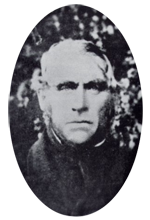|
|
Not A Surrealist - Just A Tasmanian!Miss Barsham has frequently been called a Surrealist, a description with which she is uncomfortable. Her paintings are playful and charming, but beneath the fantasy and Gothic imagination is a sharp and ironic sense of reality.
My childhood was spent among story-tellers who have passed on to me a vast collection of old family photographs. These are pictures of my ancestors, tough, uncompromising farmers with hard-working wives and independent children, woodcutters taking a smoko among their axes and cross-cut saws, great-aunts at the beach rugged up with hats, coats and umbrellas. I encountered some of the younger ones when they had become elderly relatives to be visited occasionally on Sundays. Only a fraction of a second of their lives appears in these photographs. The rest is mystery. I am free to invent and paint my own dark and twisted stories about them, and their surroundings, the bush where I grew up looking at twisted tree-limbs making writhing black silhouettes against an evening sky or gleaming white in the mid-day sun. Where I ran through spiky clumps of saggs, picked blackberries and native cherries, explored rocky hillsides and slid down sand dunes. I like paintings you can walk around in. I work from nature but play with shapes, colours and spaces to build my own little world. Much of the fun in painting is creating the illusion of a third dimension, and my work is not so much a literal representation as a poetic commentary on the environment and our place in it. Living in Tasmania, it is difficult not to be interested in the interaction between people and nature, but a major source of inspiration is the landscape itself, the coastline, forests and mountains. The hills and bushland around Hobart are still my visual world, inspiring and informing my paintings. One day I hope I will capture their true form. As a visiting friend declared upon seeing my home for the first time - You're not a Surrealist at all - you're a Tasmanian!
How I Became A Tasmanian
My maternal ancestors were an assortment of respectable English professional people and minor aristocrats whose offspring, having disgraced the family, were sent to The Colonies to seek their fortune and avoid further scandal. Here are two of them (right). They packed their artist son off to his uncle in New Zealand, where he became a journalist and illustrator and finally fled to Hobart to avoid his creditors.
Three of the Aunts are on the left. On the right is my favourite photograph of myself with my Grandmother. My great-aunts were teachers, writers, musicians and amateur painters. They taught me that real life is much more interesting than fiction, and wrote novels, short-stories, plays and poetry that were complete fictions. Reading, art, music and self-expression were encouraged. For their "literature evenings" everyone (children included) was expected to write something amusing based on a topic proposed by one of the Aunts. From them I discovered that there are many forms of truth to be drawn from the same set of facts. It all depends on your point of view, and which aspects you choose to emphasize.
What has all this to do with Tasmanian Gothic?
This is my background. I always had my nose in a book, and freely admit to sharing a deep, dark romanticism with the gloomier Victorian novelists, to a love of melodrama and to a black, slightly cynical sense of humour. I paint Tasmania, with a Gothic twist. Tasmanian Gothic, OK?
Art, Life and History - Elizabeth Barsham's blogsTASMANIAN GOTHIC BLOG DIGGING AROUND IN HISTORY THE TRAVEL DIARIES OF EDWARD WALLACE All content on this website © E.M. Christensen contact the artist: barsham@tasmanian-gothic.com |

 Figurative painting has always been a powerful means of illuminating and commenting on contemporary experience. I use traditional academic techniques and clear, glowing colours to paint heavily-patterned pictures influenced by Medieval tapestries, Durer, Breughel, Romanticism, German Expressionism and modern technology, including video and computer imagery.
Figurative painting has always been a powerful means of illuminating and commenting on contemporary experience. I use traditional academic techniques and clear, glowing colours to paint heavily-patterned pictures influenced by Medieval tapestries, Durer, Breughel, Romanticism, German Expressionism and modern technology, including video and computer imagery. 
 It has been said most of my paternal forebears were chosen by the best judges in England. Some arrived in Tasmania with Governor Collins in 1804. By that time, others had already been at Port Jackson for years. One is thought to have gone back to England, gathered up possessions and a stray brother and sailed back to Tasmania as a free settler. Another was the daughter of the temporary Commandant of Norfolk Island and one of his inmates. The rest arrived on various different ships, and all of them were here by 1845.
It has been said most of my paternal forebears were chosen by the best judges in England. Some arrived in Tasmania with Governor Collins in 1804. By that time, others had already been at Port Jackson for years. One is thought to have gone back to England, gathered up possessions and a stray brother and sailed back to Tasmania as a free settler. Another was the daughter of the temporary Commandant of Norfolk Island and one of his inmates. The rest arrived on various different ships, and all of them were here by 1845. 
 I was born on an island in Bass Strait but grew up and went to school in Lindisfarne. Although I have the usual number of parents, important influences on my formative years were my maternal grandmother and four great-aunts.
I was born on an island in Bass Strait but grew up and went to school in Lindisfarne. Although I have the usual number of parents, important influences on my formative years were my maternal grandmother and four great-aunts.